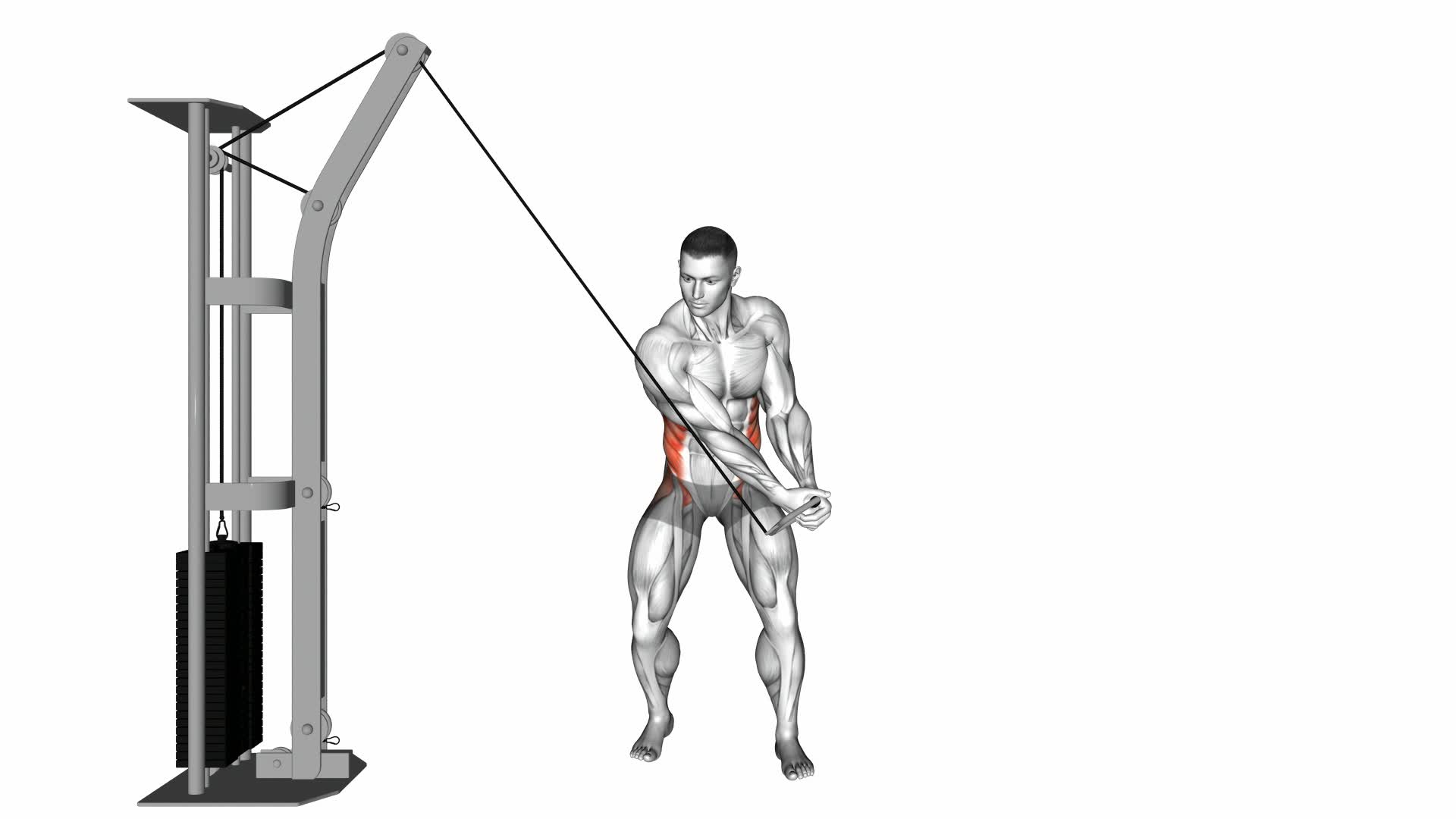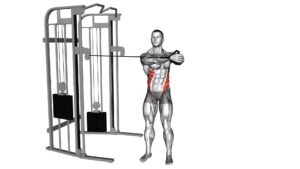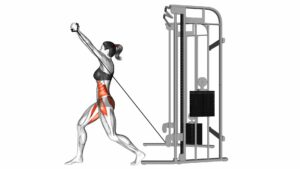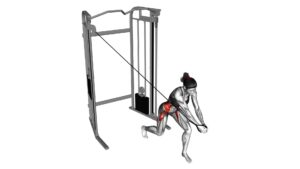Cable Twist (Up-Down) – Video Exercise Guide & Tips

Get ready to spice up your workout routine with the Cable Twist (Up-Down) exercise! In this video exercise guide, we'll show you the proper form and technique for this effective exercise.
Watch This Exercise Video
Whether you're a beginner or a seasoned pro, we've got variations and modifications to suit your fitness level. Plus, we'll share tips to help you maximize your Cable Twist (Up-Down) workouts.
So grab your equipment and let's get twisting for a stronger, more toned core!
Key Takeaways
- The Cable Twist (Up-Down) exercise enhances core stability.
- It strengthens oblique muscles and improves rotational power.
- The exercise develops a strong and stable core foundation.
- It enhances overall balance and stability.
Benefits of the Cable Twist (Up-Down) Exercise
Experience the numerous benefits of the Cable Twist (Up-Down) exercise as it enhances your core stability and strengthens your oblique muscles. This exercise is highly effective in improving your core strength and providing you with increased rotational power. By engaging your core muscles, including the deep stabilizers, the Cable Twist (Up-Down) exercise helps to develop a strong and stable core foundation. This, in turn, improves your overall balance and stability in various activities and sports.
In addition to core strength, the Cable Twist (Up-Down) exercise also targets your oblique muscles. These muscles, located on the sides of your abdomen, are responsible for rotational movements. Strengthening your oblique muscles through this exercise improves your rotational power, allowing you to generate more force when twisting or rotating your torso.
By regularly incorporating the Cable Twist (Up-Down) exercise into your fitness routine, you can expect to see improved core stability, enhanced rotational power, and increased functional strength. These benefits aren't only crucial for athletes but also for individuals looking to improve their overall fitness and performance.
Now that you understand the benefits of the Cable Twist (Up-Down) exercise, it's time to learn about the equipment needed to perform this exercise effectively.
Equipment Needed for the Cable Twist (Up-Down) Exercise
To perform the Cable Twist (Up-Down) exercise, you'll need a cable machine or resistance band. These tools are essential for providing the necessary resistance and stability to effectively engage your core muscles and improve your rotational strength. Here are the equipment options and some alternatives you can consider:
- Cable machine:
- A cable machine with an adjustable pulley system allows for varying resistance levels and a smooth range of motion.
- Attach a D-handle or rope handle to the pulley system at chest or shoulder height.
- Resistance band:
- Choose a band with sufficient resistance to challenge your muscles.
- Secure the band to an anchor point at chest or shoulder height, such as a sturdy pole or doorframe.
Benefits of rotational exercises like the Cable Twist (Up-Down) include improved core stability, increased rotational power, and enhanced sports performance. Rotational exercises also help strengthen the obliques, lower back muscles, and hip muscles.
If you don't have access to a cable machine or resistance band, there are alternative exercises you can try, such as medicine ball twists, Russian twists, or standing torso rotations with a weight plate. These exercises provide similar benefits and can be performed using common gym equipment or household items.
Remember to consult a fitness professional to ensure proper form and technique when trying alternative exercises.
Proper Form and Technique for the Cable Twist (Up-Down) Exercise
To perform the Cable Twist (Up-Down) exercise with proper form and technique, focus on engaging your core muscles and maintaining a stable position throughout the movement. This exercise is highly effective for targeting and strengthening your oblique muscles, which are responsible for rotating and stabilizing your torso. By twisting your upper body from side to side, you activate these muscles and improve your rotational strength.
Rotational exercises like the Cable Twist (Up-Down) offer several benefits. They enhance your overall core strength, stability, and balance. These exercises also help improve your sports performance, as many athletic movements involve rotational power. Additionally, incorporating rotational exercises into your workout routine can help prevent injuries by increasing the flexibility and mobility of your spine.
If you're looking for alternative exercises to further develop your core strength, you can try exercises such as Russian twists, medicine ball twists, or wood chops. These exercises target different muscles in your core and provide variations to keep your workouts interesting and challenging.
Now that you know how to perform the Cable Twist (Up-Down) exercise with proper form and understand its benefits, let's move on to the next section to explore variations and modifications for this exercise.
Variations and Modifications for the Cable Twist (Up-Down) Exercise
Now let's explore advanced modification options and important safety considerations for the cable twist (up-down) exercise.
If you're looking to challenge yourself further, there are variations that can increase the intensity and engage different muscle groups. However, it's crucial to prioritize safety and listen to your body to prevent any injuries while attempting these modifications.
Advanced Modification Options
Try incorporating a medicine ball for added resistance and difficulty during the Cable Twist (Up-Down) exercise. This advanced modification option can help to further challenge your core muscles and enhance the overall effectiveness of the exercise.
Here are two sub-lists of advanced techniques you can try:
- Increase the weight of the medicine ball gradually to continue challenging your muscles.
- Start with a lighter medicine ball and gradually progress to heavier ones as you build strength and stability.
Perform the Cable Twist (Up-Down) exercise on an unstable surface, such as a balance board or Bosu ball. This will engage your core muscles even more as they work to stabilize your body during the exercise.
Safety Considerations for Variations
To ensure safety while performing variations and modifications for the Cable Twist (Up-Down) exercise, it's important to follow proper form and listen to your body's limits. By doing so, you can prevent injuries and maximize the effectiveness of the exercise.
Before attempting any variations, it's essential to warm up your body with some light cardio exercises or dynamic stretches. This helps increase blood flow to the muscles, improves flexibility, and reduces the risk of strains or pulls.
Additionally, it's crucial to maintain proper alignment throughout the exercise, keeping your core engaged and your spine in a neutral position. If you experience any pain or discomfort, it's important to stop immediately and consult a fitness professional for guidance.
Common Mistakes to Avoid During the Cable Twist (Up-Down) Exercise
Avoid these common mistakes while performing the Cable Twist (Up-Down) exercise to maximize your results and minimize the risk of injury. Proper form and technique are crucial for getting the most out of this exercise. Here are some common mistakes to avoid:
- Using excessive weight: It's important to start with a weight that you can control throughout the entire range of motion. Using too much weight can compromise your form and increase the risk of injury.
- Twisting too quickly: Performing the Cable Twist (Up-Down) exercise with rapid movements can lead to momentum taking over and decrease the effectiveness of the exercise. Focus on controlled and deliberate movements to engage your core muscles effectively.
To ensure proper form and technique during the Cable Twist (Up-Down) exercise, remember to:
- Maintain a neutral spine: Avoid rounding or arching your back during the exercise. Keep your back straight and engage your core to stabilize your body.
- Keep your hips stable: Avoid excessive movement in your hips. Keep them facing forward throughout the exercise to target your oblique muscles effectively.
Tips for Getting the Most Out of Your Cable Twist (Up-Down) Workouts
To maximize your Cable Twist (Up-Down) workouts and achieve the best results, it's crucial to focus on engaging your core muscles. This exercise primarily targets your obliques, so make sure to maintain proper form and technique throughout.
Here are some tips to help you get the most out of your Cable Twist (Up-Down) workouts:
- Start with a suitable weight: Choose a weight that challenges you but allows you to maintain control and proper form. Gradually increase the resistance as you progress to continue challenging your muscles.
- Maintain proper posture: Stand tall with your feet shoulder-width apart and your core engaged. Avoid rounding your back or hunching your shoulders, as this can reduce the effectiveness of the exercise.
- Control the movement: Focus on a slow and controlled motion, both on the way up and down. This will maximize the engagement of your core muscles and prevent momentum from taking over.
- Incorporate progress tracking: Keep a record of the weights you use and the number of sets and repetitions performed. This will help you track your progress over time and make adjustments to your workouts accordingly.
Frequently Asked Questions
Can the Cable Twist (Up-Down) Exercise Help Me Lose Belly Fat?
The cable twist (up-down) exercise can definitely help you lose belly fat. By incorporating this exercise into your workout routine, you can target and engage your oblique muscles, which can contribute to a more toned and defined midsection.
To perform the cable twist (up-down) exercise properly for maximum results, follow these steps:
- Stand with your feet shoulder-width apart.
- Hold the cable handle with both hands.
- Twist your torso from side to side in a controlled motion.
Remember to maintain proper form and breathe throughout the exercise.
How Many Sets and Reps Should I Do for the Cable Twist (Up-Down) Exercise?
To determine how many sets and reps you should do for the cable twist (up-down) exercise, it's important to consider your fitness goals and overall fitness level.
Start with a weight that challenges you but allows you to maintain proper form throughout the exercise.
Aim for 3-4 sets of 10-15 reps per side, with a brief rest between sets.
Remember to engage your core and twist from your hips, not just your arms, to get the most out of this exercise.
Can I Perform the Cable Twist (Up-Down) Exercise if I Have Lower Back Pain?
Yes, you can perform the cable twist (up-down) exercise if you have lower back pain. However, it's important to modify the exercise to avoid aggravating your condition.
You can decrease the weight, reduce the range of motion, or perform alternative exercises that target the same muscles without putting strain on your lower back.
Consult with a fitness professional or physical therapist to determine the best modifications or alternative exercises for your specific needs.
Is the Cable Twist (Up-Down) Exercise Suitable for Beginners?
Yes, the cable twist (up-down) exercise is suitable for beginners. It's a great way to work on your core strength. If you're new to this exercise, there are modifications you can make to make it easier.
The cable twist targets your obliques, abs, and lower back, helping to improve stability and overall strength. It's important to start with lighter weights and focus on proper form to avoid any strain on your lower back.
Can I Do the Cable Twist (Up-Down) Exercise With a Resistance Band Instead of a Cable Machine?
Yes, you can do the cable twist (up-down) exercise with a resistance band instead of a cable machine. Using a resistance band as an alternative provides similar benefits to using a cable machine.
Both exercises target your obliques and help improve core strength and stability.
However, it's important to note that the resistance band may not provide the same level of resistance as a cable machine, so you may need to adjust the band tension accordingly.
Conclusion
In conclusion, the Cable Twist (Up-Down) exercise is a highly effective way to work your core muscles and improve rotational strength. With the right equipment and proper form, you can reap the benefits of this exercise, including increased stability and flexibility.
Remember to avoid common mistakes and explore variations to keep your workouts challenging and effective. By following these tips, you can make the most out of your Cable Twist (Up-Down) workouts and achieve your fitness goals.

Author
Years ago, the spark of my life’s passion ignited in my mind the moment I stepped into the local gym for the first time. The inaugural bead of perspiration, the initial endeavor, the very first surge of endorphins, and a sense of pride that washed over me post-workout marked the beginning of my deep-seated interest in strength sports, fitness, and sports nutrition. This very curiosity blossomed rapidly into a profound fascination, propelling me to earn a Master’s degree in Physical Education from the Academy of Physical Education in Krakow, followed by a Sports Manager diploma from the Jagiellonian University. My journey of growth led me to gain more specialized qualifications, such as being a certified personal trainer with a focus on sports dietetics, a lifeguard, and an instructor for wellness and corrective gymnastics. Theoretical knowledge paired seamlessly with practical experience, reinforcing my belief that the transformation of individuals under my guidance was also a reflection of my personal growth. This belief holds true even today. Each day, I strive to push the boundaries and explore new realms. These realms gently elevate me to greater heights. The unique combination of passion for my field and the continuous quest for growth fuels my drive to break new ground.







